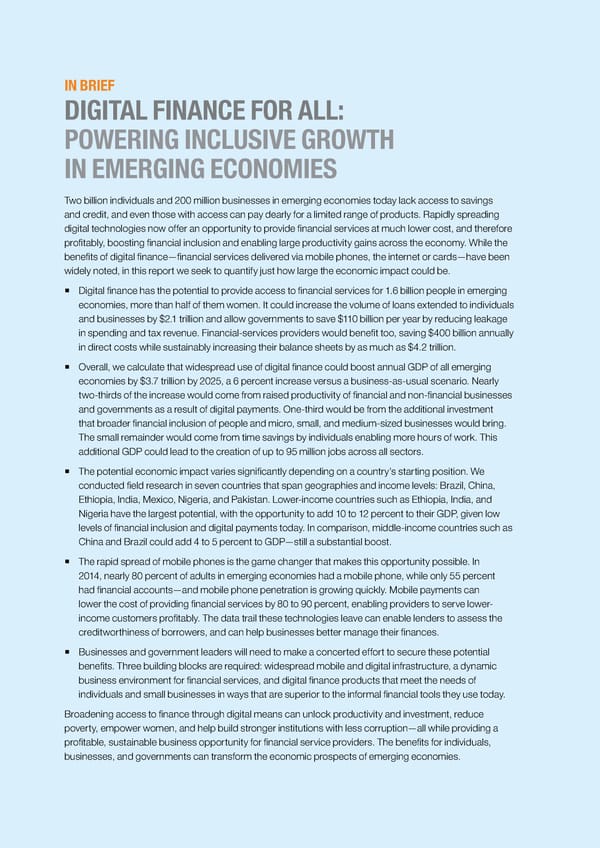IN BRIEF DIGITAL FINANCE FOR ALL: POWERING INCLUSIVE GROWTH IN EMERGING ECONOMIES Two billion individuals and 200 million businesses in emerging economies today lack access to savings and credit, and even those with access can pay dearly for a limited range of products. Rapidly spreading digital technologies now offer an opportunity to provide financial services at much lower cost, and therefore profitably, boosting financial inclusion and enabling large productivity gains across the economy. While the benefits of digital finance—financial services delivered via mobile phones, the internet or cards—have been widely noted, in this report we seek to quantify just how large the economic impact could be. ƒ Digital finance has the potential to provide access to financial services for 1.6 billion people in emerging economies, more than half of them women. It could increase the volume of loans extended to individuals and businesses by $2.1 trillion and allow governments to save $110 billion per year by reducing leakage in spending and tax revenue. Financial-services providers would benefit too, saving $400 billion annually in direct costs while sustainably increasing their balance sheets by as much as $4.2 trillion. ƒ Overall, we calculate that widespread use of digital finance could boost annual GDP of all emerging economies by $3.7 trillion by 2025, a 6 percent increase versus a business-as-usual scenario. Nearly two-thirds of the increase would come from raised productivity of financial and non-financial businesses and governments as a result of digital payments. One-third would be from the additional investment that broader financial inclusion of people and micro, small, and medium-sized businesses would bring. The small remainder would come from time savings by individuals enabling more hours of work. This additional GDP could lead to the creation of up to 95 million jobs across all sectors. ƒ The potential economic impact varies significantly depending on a country’s starting position. We conducted field research in seven countries that span geographies and income levels: Brazil, China, Ethiopia, India, Mexico, Nigeria, and Pakistan. Lower-income countries such as Ethiopia, India, and Nigeria have the largest potential, with the opportunity to add 10 to 12 percent to their GDP, given low levels of financial inclusion and digital payments today. In comparison, middle-income countries such as China and Brazil could add 4 to 5 percent to GDP—still a substantial boost. ƒ The rapid spread of mobile phones is the game changer that makes this opportunity possible. In 2014, nearly 80 percent of adults in emerging economies had a mobile phone, while only 55 percent had financial accounts—and mobile phone penetration is growing quickly. Mobile payments can lower the cost of providing financial services by 80 to 90 percent, enabling providers to serve lower- income customers profitably. The data trail these technologies leave can enable lenders to assess the creditworthiness of borrowers, and can help businesses better manage their finances. ƒ Businesses and government leaders will need to make a concerted effort to secure these potential benefits. Three building blocks are required: widespread mobile and digital infrastructure, a dynamic business environment for financial services, and digital finance products that meet the needs of individuals and small businesses in ways that are superior to the informal financial tools they use today. Broadening access to finance through digital means can unlock productivity and investment, reduce poverty, empower women, and help build stronger institutions with less corruption—all while providing a profitable, sustainable business opportunity for financial service providers. The benefits for individuals, businesses, and governments can transform the economic prospects of emerging economies.
 DIGITAL FINANCE FOR ALL Page 7 Page 9
DIGITAL FINANCE FOR ALL Page 7 Page 9